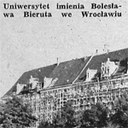0215 Art Historiography on the Main Building of the University of Wrocław – A Battlefield of Ideologies
Identifiers (Article)
Identifiers (Files)
Abstract
The main building of the University of Wrocław, with its magnificent façade facing the Odra River, is one of the most important historical monuments of the city and a major tourist attraction. It also houses a significant institution in the Polish educational landscape. Founded by Jesuits and built in early eighteenth-century Baroque style, the University is closely connected with the history of the Habsburg monarchy and its Counter-Reformation aims. For this reason, after 1945, its heritage was difficult to reconcile with the official Communist ideology and its initially anti-German sentiments. This article tackles the question of how both art historiography and the popular media, including guidebooks and the press of the People’s Republic of Poland, became engaged in the task of proving the Polish roots of the University of Wrocław. To this end, we provide an overview of the shifting interpretations and attributions of the Baroque edifice from its beginnings in the eighteenth century until the second decade of the twenty-first century in order to highlight the features specific to the discourse in Socialist times.
Statistics


License

This work is licensed under a Creative Commons Attribution-NonCommercial-NoDerivatives 4.0 International License.



